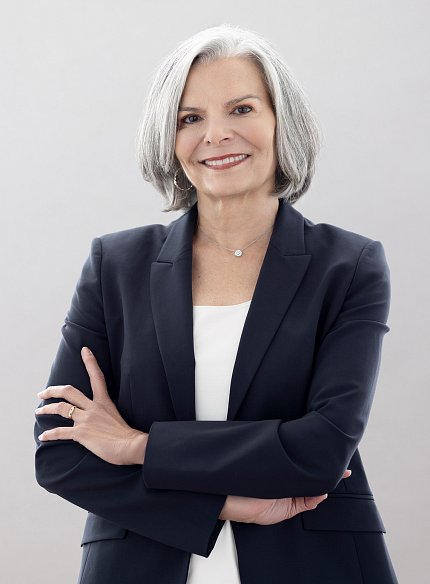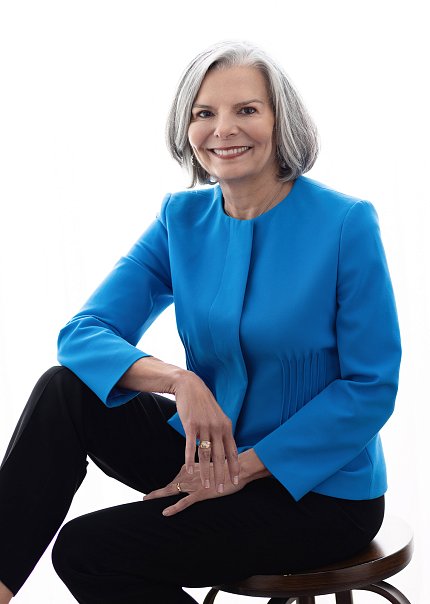‘Assume Good Intent’
At FNIH Helm, Gerberding Sets Ambitious Agenda

Of all the roles Dr. Julie Gerberding has served in throughout her career, physician is the one that has served her best. In fact, when communicating important messages or under difficult circumstances, she instinctively adopts her caregiver mode, “How would I convey this to my patient, one on one?”
A little more than a year into her post as president and CEO of the Foundation for the National Institutes of Health (FNIH), Gerberding will deploy her default persona more now for her latest challenge—galvanizing like-minded allies to reach ambitious goals in a post-pandemic world.
“When we looked across the whole spectrum of what NIH and what science can do, there probably has never been a more optimistic point in time—if we’re just thinking about the possibilities of science,” she said in a recent interview. “It’s also a sobering reminder that society isn’t always on our side and the context in which we are operating is very challenging for scientists and for citizens. That’s all the more reason to forge partnerships and alliances so that we can be a whole greater than the sum of our parts and find common ground to move important agendas forward.”
Chartered by Congress in 1990 to facilitate groundbreaking NIH research, FNIH largely aligns its agendas with those of the world’s largest biomedical research enterprise. The not-for-profit organization has raised more than $1.5 billion to support NIH’s mission over more than three decades. FNIH manages and provides resources and structure for large-scale scientific endeavors that often involve multiple partners from both public and private sectors as well as academic and philanthropic institutions.
Gerberding took the FNIH helm in May 2022, after spending more than a decade at Merck & Co., Inc. as president of the vaccines business and chief patient officer. Before that she served for 11 years in senior leadership at the Centers for Disease Control and Prevention (CDC), guiding the agency as director through the global SARS (severe acute respiratory syndrome) outbreak and many other public health crises.
In the past couple of decades, Gerberding has seen the greater medical science movement face some formidable obstacles, including the worst global pandemic in a century. How to recover and advance?
“Part of the challenges we’re facing right now is just competing priorities,” she said. “There are so many ways in which people outside of government can invest their resources and their time. To make sure we have the right participation—from the scientific perspective, but also from the financial perspective—that we need to move these partnerships forward, we have to be able to articulate a compelling argument about the value we can create. I actually think it’s very easy, because there aren’t too many organizations that can bring together the incredible scientific leadership of NIH, with the scientific leadership of our biopharmaceutical industry and the scientific leadership of our academic institutions. When you bring that firepower together to concentrate on a shared challenge, you can perform miracles.”
In the vein of miracles—feeding multitudes with sparse resources, for example—Gerberding believes in thinking big.
“We really are excited about expanding our portfolio of partnerships—and expanding them not just into new therapeutic areas of health. We’re also looking at new health tech partners who have digital biomarkers opportunities or new devices that can help monitor patients’ clinical status and help patients have a more precise approach to medical decision-making.”
FNIH also hopes to grow initiatives geographically. It’s exploring ideas that emerged from the advisory committee for the Fogarty International Center, for instance, to pursue more global framing for partnership models.
In addition, Gerberding said FNIH wants to help speed up the pace of partnership design, development and implementation.
“We’re hoping two things,” she said. “One is that we’re going to have a fundraising campaign so that we have the unrestricted resources to help jumpstart things ahead of the budget year and maybe get some projects launched a little bit faster. The other thing is we are doing some improvements in contracting—finding innovative ways to contract not only with NIH but also with our outside partners. For example, instead of making each agreement a completely separate standalone agreement, we can develop a master agreement and then issue task orders from it.”

Another crucial component of Gerberding’s agenda is shoring up the people behind the breakthroughs.
“We’ve been talking about supporting science, but we also have a long tradition of supporting scientists—both intramurally at NIH and extramurally,” she noted. “That’s an opportunity where we hope we can come up with ways to be helpful in a big challenge that everyone is facing—postdoc salary limitations. [It’s] discouraging really talented people from staying in academia or pursuing their research careers.”
Gerberding began her own career in science as chief medical resident at the University of California San Francisco (UCSF). She served as an associate professor at UCSF and as director of the Epidemiology and Prevention Interventions Center at San Francisco General Hospital. She collaborated with Dr. David Henderson at NIH’s Clinical Center to develop the first post-exposure prophylaxis protocol to prevent occupational HIV infection in health care workers and was on the frontlines treating some of the first patients with HIV/AIDS.
Academia, government, private sector and nonprofit. Having first-hand experience from several different perspectives has provided Gerberding with both a diverse skillset and a unique vantage point for tackling what may be the biggest global health threat yet.
“I think all of us share the belief that—at the end of the day—trust in science is very important,” Gerberding observed. “We are working with our patient organizations and our patients who are a part of our overall partnership portfolio to think how we can build more understanding of the process of science, but also more trust in how science is conducted and how people can use that science to make better decisions. So, science, scientists and trust in science—that’s our portfolio.”
Gerberding has been interested in science ever since Santa left her a doctor’s kit when she was a youngster growing up in Estelline, a city of fewer than 1,000 people in South Dakota. She’s built on and invested in that early-life curiosity throughout her career, always employing some good advice she got along the way.
“Assume good intent,” she counsels others and reminds herself as she advances toward the next goal. “Whether you’re dealing with an interpersonal environment, or whether you’re dealing with a large organization, sometimes people default to mistrust as their starting point. And then you interpret everything in that sense. But if you learn to adjust your thinking and assume good intent as the starting point until proven otherwise, it opens up the door to a very different framework—not only for relationships with people, but also for many opportunities.”
